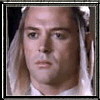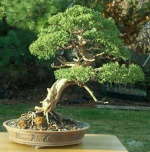A collected Rocky Mountain Juniper
+10
lordy
Andrew Legg
marcus watts
Brian Van Fleet
stagz
dick benbow
Fore
JudyB
Jesse McMahon
Dave Murphy
14 posters
Page 2 of 2
Page 2 of 2 •  1, 2
1, 2
 Re: A collected Rocky Mountain Juniper
Re: A collected Rocky Mountain Juniper
Man, Dave that thing is HUGE. Look how much bigger it is than that lady in the blue pants standing under it! 

lordy- Member
 Re: A collected Rocky Mountain Juniper
Re: A collected Rocky Mountain Juniper
Thanks Andrew. The picture was taken a few degrees left of spot on front. The live vein is very visible from there, and I did not peel the more mature bark down to the brighter reddish new bark and oil itAndrew Legg wrote:Hi Dave,
Great job mate. The tree has come a long way since being owned by yourself. My question is what's behind all that deadwood? For me, it looks like a lovelys green top growing on a dead stem. Is it possible to rotate the front a bit to show some more of the live vein? Just a thought. Cool tree.
Cheers,
Andrew
Dave Murphy- Member
 Re: A collected Rocky Mountain Juniper
Re: A collected Rocky Mountain Juniper
lordy wrote:Man, Dave that thing is HUGE. Look how much bigger it is than that lady in the blue pants standing under it!
Yes, very big. I did need help to put it on the stand, but I usually move this one around by myself

Dave Murphy- Member
 Re: A collected Rocky Mountain Juniper
Re: A collected Rocky Mountain Juniper
Dave Murphy wrote:
Thanks Andrew. The picture was taken a few degrees left of spot on front. The live vein is very visible from there, and I did not peel the more mature bark down to the brighter reddish new bark and oil it. You can see from earlier photos how well the live vein pops when I do.
Hi Dave.
In my mind there's something to be said for not peeling and polishing junipers too. Makes them look a bit plasticy in my mind, but hey, different strokes for different folks right.
Cheers,
Andrew
Andrew Legg- Member
 Re: A collected Rocky Mountain Juniper
Re: A collected Rocky Mountain Juniper
Well, I guess if you have a juni without deadwood, not pealing the bark would make sense. But if a lot of deadwood it would make sense to contrast the live vein from the deadwood by peeling and polishing that live vein 

YukiShiro- Member
 Re: A collected Rocky Mountain Juniper
Re: A collected Rocky Mountain Juniper
With collected trees/yamadori, you must remove bark to look for borers. Been cleaning quite a bit of l. veins recently and just found my first borer this weekend. If you don't look, it might just kill you tree.

Fore- Member
 Re: A collected Rocky Mountain Juniper
Re: A collected Rocky Mountain Juniper
I really like the tree but I would like to ask a question? What technique are you using to tighten up the foliage and create clouds or masses?

Vance Wood- Member
 Re: A collected Rocky Mountain Juniper
Re: A collected Rocky Mountain Juniper
Vance Wood wrote:I really like the tree but I would like to ask a question? What technique are you using to tighten up the foliage and create clouds or masses?
Wiring and cutting back extensions...no pinching. For the first time in over 4 years, the majority of the foliage is moving toward the adult scale type. I have no doubt that if I started pinching the foliage tips, it would all shortly revert to juvenile foliage.
Dave Murphy- Member
 Re: A collected Rocky Mountain Juniper
Re: A collected Rocky Mountain Juniper
Dave,
I really enjoyed reading the history of your exquisite RMJ and the contribution to it made by Ryan Neil. I have two questions:
1) What is the difference between "cutting back extensions" and "pinching"
2) What and how frequently are you feeding your RMJ?
I really enjoyed reading the history of your exquisite RMJ and the contribution to it made by Ryan Neil. I have two questions:
1) What is the difference between "cutting back extensions" and "pinching"
2) What and how frequently are you feeding your RMJ?

Barry Grayson- Member
 Re: A collected Rocky Mountain Juniper
Re: A collected Rocky Mountain Juniper
Thanks Barry. In my mind, pinching is a term that describes the removal, by fingers, of the growing tips of the juniper foliage. Cutting back extensions refers to the removal, with pruning shears, of stronger growth that has extended beyond the silhouette of the pad. These extensions tend to be, at least on this tree, more then several inches long when removed, and more often then not, the cut is made into lignified, woody tissue.
As far as fertilizing, I give a full strength shot of miracle gro liquid and fish emulsion every week or two during our fairly long growing season. This one will be getting less fertilizer as it becomes more refined.
As far as fertilizing, I give a full strength shot of miracle gro liquid and fish emulsion every week or two during our fairly long growing season. This one will be getting less fertilizer as it becomes more refined.
Dave Murphy- Member
 Re: A collected Rocky Mountain Juniper
Re: A collected Rocky Mountain Juniper
Dave Murphy wrote:Thanks Barry. In my mind, pinching is a term that describes the removal, by fingers, of the growing tips of the juniper foliage. Cutting back extensions refers to the removal, with pruning shears, of stronger growth that has extended beyond the silhouette of the pad. These extensions tend to be, at least on this tree, more then several inches long when removed, and more often then not, the cut is made into lignified, woody tissue.
As far as fertilizing, I give a full strength shot of miracle gro liquid and fish emulsion every week or two during our fairly long growing season. This one will be getting less fertilizer as it becomes more refined.
Here is the problem I am having with this debate or discussion and is probably bassed in semantics. We need to define what we mean. I have been growing Junipers of more years than some of you have been breathing air. I have a method of pinching, as we used to call it, that is designed to develop the cloud like foliage pads that many covet in Juniper bonsai. I have never seen or felt that what I do weakens or endangers a tree in the least and I do not get brown ends from the process as some proponents of your method seem to claim. You answered Barry's post starting with the following: Cutting back extensions refers to the removal, with pruning shears, of stronger growth that has extended beyond the silhouette of the pad. Does this mean that you cut back everything that has grown out, even a little bit, beyond the shape you are trying to maintain? OR--- do you wait till they have extended as you describe here: These extensions tend to be, at least on this tree, more then several inches long when removed, and more often then not, the cut is made into lignified, woody tissue.
If it is so, as you have described, why do you wait till a growth beyond the silhouette advances to "more than several inches" before you deal with it. Assuming that this is the crux of this method, what do you do with growth that is only a couple of milimeters? The growth we used to, and God forgive me, PINCH. How do you deal with that or do you have to wait till it progresses to "more than several inches"? The Shimpaku I use for my Avatar has been pinched since 1994 and it still seems to look OK. Just because some Japanese master or some student of a Japanese Master says this or says that does not necessarily mean it should be accepted without question. I'm really sorry and I do not wish to stir up a fuss but I have not been able to get a straight answer about this, and most of the Junipers I have seen by the proponents of this method look like ten year old boys in need of a hair cut. Sorry

Vance Wood- Member
 Re: A collected Rocky Mountain Juniper
Re: A collected Rocky Mountain Juniper
Vance, honestly, do what works for you. I've described in detail how I've styled and developed this tree. This is a Rocky Mountain Juniper, probably over 500 years old and maybe closer to 1000 years old, now living just north of Atlanta, GA. It reverts to 100% juvenile foliage every time I repot it or wire it heavily. After 3 years of pruning the foliage as I've described, the foliage is swinging back to mostly scale foliage, meaning the technique is working for me, the tree is healthy, AND I like the way the foliage looks on this particular tree. For me, the conversation begins and ends there.
Dave Murphy- Member
 Re: A collected Rocky Mountain Juniper
Re: A collected Rocky Mountain Juniper
Dave Murphy wrote:Vance, honestly, do what works for you. I've described in detail how I've styled and developed this tree. This is a Rocky Mountain Juniper, probably over 500 years old and maybe closer to 1000 years old, now living just north of Atlanta, GA. It reverts to 100% juvenile foliage every time I repot it or wire it heavily. After 3 years of pruning the foliage as I've described, the foliage is swinging back to mostly scale foliage, meaning the technique is working for me, the tree is healthy, AND I like the way the foliage looks on this particular tree. For me, the conversation begins and ends there.
I am glad, in sincerely like the tree and I sincerely like you and would not cause you grief or anger in my direction. But I have to keep asking because I do not know. Having someone tell me that they have it written on their blog, or they have told me already, or both does not fly. I feel like I am being asked to buy the King's New Clothes. If your description of what you do is summed up in the previous post than I think we have a problem. You still have not described what you do with the little stuff? My assumption from reading your post was that you allow the new growth to advance to two or three inches beyond your intended silhouette before you deal with it? Then you cut it back to lignified wood, below your intended silhouette? This means you have to constantly regrow everything all the time and never really reach a defined profile? This does not make sense? The way Junipers grow you are constantly fighting a stylistic battle you can't really win. When I thin my pads, usually once a year I cut back to lignified wood but I don't wait tlll the tree grows out of profile by two or three inches before taking care of the problem.
I know some of "you guys" describe the pinching method as ripping off and tearing the new growth. Well that is not true at all and anyone who approaches a Juniper in this way deserves the brown ends and the weakened tree, they would be better served if they had taken a pair of shrub shears or an electrical hedge clipper and had a go at the tree.

Vance Wood- Member
 Re: A collected Rocky Mountain Juniper
Re: A collected Rocky Mountain Juniper
I'll preface this post by saying that I am not a student of Boon or Ryan Neil, though I spend time with Rodney Clemons, and he has never told me one way or the other how to prune this tree. He did judge it at the ABS annual show and had nothing to say, good or bad, about the canopy or foliage. I read about this technique years ago, listened to Ryan talk about it during a club meeting years ago, it made sense to me, so it's become the primary technique I'm using with my junipers. As to your question about the small stuff, I don't do anything to it unless I'm cleaning the tree up to be shown. Then I'll trim the small stuff back to fit within the silhouette, and this is usually done within several days of the event. I suppose if I was a student of Boon or Ryan, they might have different advice on technique or timing. The tree is a bit unkempt most of the time, but it's healthy, which is most important. I've lost old collected trees before...losing this one would gut me.
Dave Murphy- Member
 Re: A collected Rocky Mountain Juniper
Re: A collected Rocky Mountain Juniper
I think what this debate boils down to is that there's more than one way to skin a cat.

JimLewis- Member
 Re: A collected Rocky Mountain Juniper
Re: A collected Rocky Mountain Juniper
JimLewis wrote:I think what this debate boils down to is that there's more than one way to skin a cat.
I wish that was true but I have found it to be otherwise. Dave I'm sorry to have lumped you into that new mantra.
Last edited by Vance Wood on Thu Aug 21, 2014 1:42 pm; edited 1 time in total

Vance Wood- Member
 Re: A collected Rocky Mountain Juniper
Re: A collected Rocky Mountain Juniper
Dave Murphy wrote:I'll preface this post by saying that I am not a student of Boon or Ryan Neil, though I spend time with Rodney Clemons, and he has never told me one way or the other how to prune this tree. He did judge it at the ABS annual show and had nothing to say, good or bad, about the canopy or foliage. I read about this technique years ago, listened to Ryan talk about it during a club meeting years ago, it made sense to me, so it's become the primary technique I'm using with my junipers. As to your question about the small stuff, I don't do anything to it unless I'm cleaning the tree up to be shown. Then I'll trim the small stuff back to fit within the silhouette, and this is usually done within several days of the event. I suppose if I was a student of Boon or Ryan, they might have different advice on technique or timing. The tree is a bit unkempt most of the time, but it's healthy, which is most important. I've lost old collected trees before...losing this one would gut me.
I would humbly beg of you one final question because so far, you are the only one who has been forward about this subject and I thank you for that. I realize you are not a student of Ryan or Boon but you did mention that you and Ryan worked on this tree at one time and you are familiar with the technique of reducing (?) the foliage. Your quote: ----listened to Ryan talk about it during a club meeting years ago, it made sense to me, so it's become the primary technique I'm using with my junipers. You do not have to be a direct student of a teacher to follow their teachings. You mention this and it is this point that bothers me the most about this process, and the point where this technique becomes vague and ambiguous: As to your question about the small stuff, I don't do anything to it unless I'm cleaning the tree up to be shown. Then I'll trim the small stuff back to fit within the silhouette, and this is usually done within several days of the event.
Can you define for me how you trim this growth for a showing?
You wrote: The tree is a bit unkempt most of the time, but it's healthy, which is most important. I've lost old collected trees before...losing this one would gut me. Dave---- I absolutely agree with you on this. I would not even suggest that you change anything. This is a magnificent tree deserving the best care possible, and you seem to be providing it. Thank You for you straight forward answers and your lack of a condescending attitude about it. I have asked about this method before and for the most part received some rather rude, condescending, and vague advise like it's a big secret to the details.

Vance Wood- Member
 Re: A collected Rocky Mountain Juniper
Re: A collected Rocky Mountain Juniper
My pre show cleanup involves using shears to cut back the newer growth to fit the silhouette.
This has basically been an experiment for me, as I've got no one with more experience then myself to advise or assure me of the results of applying this technique to an RMJ in GA. The reason I like this technique is mainly because the tree is always allowed to grow strongly, which helps assure a healthy tree and adult foliage. Don't forget, too, that this one is still early in it's bonsai life. I suspect that, over the next few years, the foliage will continue to tighten up and look less unkempt.
This has basically been an experiment for me, as I've got no one with more experience then myself to advise or assure me of the results of applying this technique to an RMJ in GA. The reason I like this technique is mainly because the tree is always allowed to grow strongly, which helps assure a healthy tree and adult foliage. Don't forget, too, that this one is still early in it's bonsai life. I suspect that, over the next few years, the foliage will continue to tighten up and look less unkempt.
Dave Murphy- Member
 Re: A collected Rocky Mountain Juniper
Re: A collected Rocky Mountain Juniper
Dave Murphy wrote:My pre show cleanup involves using shears to cut back the newer growth to fit the silhouette.
This has basically been an experiment for me, as I've got no one with more experience then myself to advise or assure me of the results of applying this technique to an RMJ in GA. The reason I like this technique is mainly because the tree is always allowed to grow strongly, which helps assure a healthy tree and adult foliage. Don't forget, too, that this one is still early in it's bonsai life. I suspect that, over the next few years, the foliage will continue to tighten up and look less unkempt.
Thank you for your honesty. I did not mean to suggest that your tree is unkempt in the same way I meant it about some trees I am starting to see from adherents to this method. Having seen multiple examples of this tree in the wild I know how much work you have done with it and how far those efforts have taken it. The early photo of the tree had me thinking that this tree would not make it. It would be kindling for Phoenix grafts, usually really bad ones too.

Vance Wood- Member
Page 2 of 2 •  1, 2
1, 2
 Similar topics
Similar topics» Yamadori Rocky Mountain Juniper
» Small Rocky Mountain Juniper
» Deadwood Rocky Mountain Juniper
» Mahogany stand for a Rocky Mountain Juniper
» Juniperus scopulorum - Rocky Mountain Juniper First Styling
» Small Rocky Mountain Juniper
» Deadwood Rocky Mountain Juniper
» Mahogany stand for a Rocky Mountain Juniper
» Juniperus scopulorum - Rocky Mountain Juniper First Styling
Page 2 of 2
Permissions in this forum:
You cannot reply to topics in this forum






